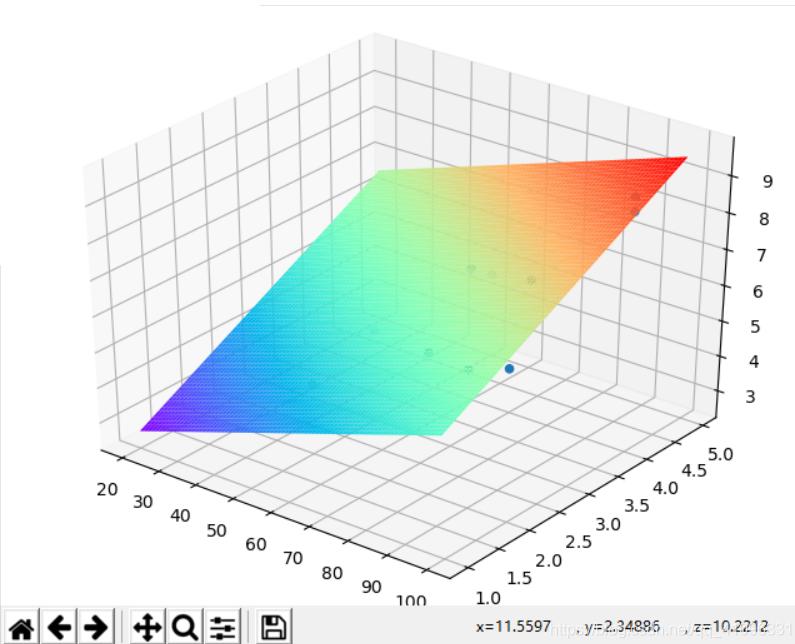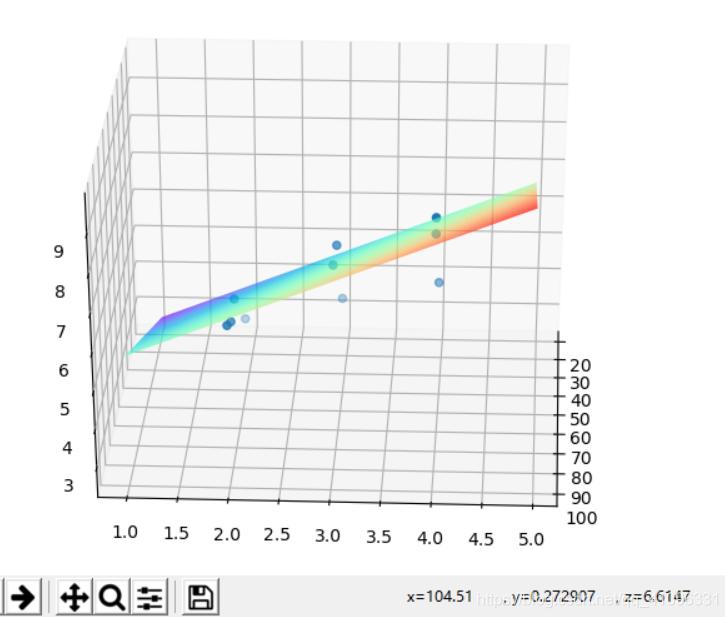python版本选择
这里选的python版本是2.7,因为我之前用python3试了几次,发现在画3d图的时候会报错,所以改用了2.7。
数据集选择
数据集我选了一个包含两个变量,三个参数的数据集,这样可以画出3d图形对结果进行验证。
部分函数总结
symbols()函数:首先要安装sympy库才可以使用。用法:
>>> x1 = symbols('x2') >>> x1 + 1 x2 + 1在这个例子中,x1和x2是不一样的,x2代表的是一个函数的变量,而x1代表的是python中的一个变量,它可以表示函数的变量,也可以表示其他的任何量,它替代x2进行函数的计算。实际使用的时候我们可以将x1,x2都命名为x,但是我们要知道他们俩的区别。
再看看这个例子:>>> x = symbols('x') >>> expr = x + 1 >>> x = 2 >>> print(expr) x + 1作为python变量的x被2这个数值覆盖了,所以它现在不再表示函数变量x,而expr依然是函数变量x+1的别名,所以结果依然是x+1。
subs()函数:既然普通的方法无法为函数变量赋值,那就肯定有函数来实现这个功能,用法:>>> (1 + x*y).subs(x, pi)#一个参数时的用法 pi*y + 1 >>> (1 + x*y).subs({x:pi, y:2})#多个参数时的用法 1 + 2*pidiff()函数:求偏导数,用法:result=diff(fun,x),这个就是求fun函数对x变量的偏导数,结果result也是一个变量,需要赋值才能得到准确结果。
代码实现:
from __future__ import division from sympy import symbols, diff, expand import numpy as np import matplotlib.pyplot as plt from mpl_toolkits.mplot3d import Axes3D data = {'x1': [100, 50, 100, 100, 50, 80, 75, 65, 90, 90], 'x2': [4, 3, 4, 2, 2, 2, 3, 4, 3, 2], 'y': [9.3, 4.8, 8.9, 6.5, 4.2, 6.2, 7.4, 6.0, 7.6, 6.1]}#初始化数据集 theta0, theta1, theta2 = symbols('theta0 theta1 theta2', real=True) # y=theta0+theta1*x1+theta2*x2,定义参数 costfuc = 0 * theta0 for i in range(10): costfuc += (theta0 + theta1 * data['x1'][i] + theta2 * data['x2'][i] - data['y'][i]) ** 2 costfuc /= 20#初始化代价函数 dtheta0 = diff(costfuc, theta0) dtheta1 = diff(costfuc, theta1) dtheta2 = diff(costfuc, theta2) rtheta0 = 1 rtheta1 = 1 rtheta2 = 1#为参数赋初始值 costvalue = costfuc.subs({theta0: rtheta0, theta1: rtheta1, theta2: rtheta2}) newcostvalue = 0#用cost的值的变化程度来判断是否已经到最小值了 count = 0 alpha = 0.0001#设置学习率,一定要设置的比较小,否则无法到达最小值 while (costvalue - newcostvalue > 0.00001 or newcostvalue - costvalue > 0.00001) and count < 1000: count += 1 costvalue = newcostvalue rtheta0 = rtheta0 - alpha * dtheta0.subs({theta0: rtheta0, theta1: rtheta1, theta2: rtheta2}) rtheta1 = rtheta1 - alpha * dtheta1.subs({theta0: rtheta0, theta1: rtheta1, theta2: rtheta2}) rtheta2 = rtheta2 - alpha * dtheta2.subs({theta0: rtheta0, theta1: rtheta1, theta2: rtheta2}) newcostvalue = costfuc.subs({theta0: rtheta0, theta1: rtheta1, theta2: rtheta2}) rtheta0 = round(rtheta0, 4) rtheta1 = round(rtheta1, 4) rtheta2 = round(rtheta2, 4)#给结果保留4位小数,防止数值溢出 print(rtheta0, rtheta1, rtheta2) fig = plt.figure() ax = Axes3D(fig) ax.scatter(data['x1'], data['x2'], data['y']) # 绘制散点图 xx = np.arange(20, 100, 1) yy = np.arange(1, 5, 0.05) X, Y = np.meshgrid(xx, yy) Z = X * rtheta1 + Y * rtheta2 + rtheta0 ax.plot_surface(X, Y, Z, rstride=1, cstride=1, cmap=plt.get_cmap('rainbow')) plt.show()#绘制3d图进行验证结果:


实例扩展:
''' 梯度下降算法 Batch Gradient Descent Stochastic Gradient Descent SGD ''' __author__ = 'epleone' import numpy as np import matplotlib.pyplot as plt from mpl_toolkits.mplot3d import Axes3D import sys # 使用随机数种子, 让每次的随机数生成相同,方便调试 # np.random.seed(111111111) class GradientDescent(object): eps = 1.0e-8 max_iter = 1000000 # 暂时不需要 dim = 1 func_args = [2.1, 2.7] # [w_0, .., w_dim, b] def __init__(self, func_arg=None, N=1000): self.data_num = N if func_arg is not None: self.FuncArgs = func_arg self._getData() def _getData(self): x = 20 * (np.random.rand(self.data_num, self.dim) - 0.5) b_1 = np.ones((self.data_num, 1), dtype=np.float) # x = np.concatenate((x, b_1), axis=1) self.x = np.concatenate((x, b_1), axis=1) def func(self, x): # noise太大的话, 梯度下降法失去作用 noise = 0.01 * np.random.randn(self.data_num) + 0 w = np.array(self.func_args) # y1 = w * self.x[0, ] # 直接相乘 y = np.dot(self.x, w) # 矩阵乘法 y += noise return y @property def FuncArgs(self): return self.func_args @FuncArgs.setter def FuncArgs(self, args): if not isinstance(args, list): raise Exception( 'args is not list, it should be like [w_0, ..., w_dim, b]') if len(args) == 0: raise Exception('args is empty list!!') if len(args) == 1: args.append(0.0) self.func_args = args self.dim = len(args) - 1 self._getData() @property def EPS(self): return self.eps @EPS.setter def EPS(self, value): if not isinstance(value, float) and not isinstance(value, int): raise Exception("The type of eps should be an float number") self.eps = value def plotFunc(self): # 一维画图 if self.dim == 1: # x = np.sort(self.x, axis=0) x = self.x y = self.func(x) fig, ax = plt.subplots() ax.plot(x, y, 'o') ax.set(xlabel='x ', ylabel='y', title='Loss Curve') ax.grid() plt.show() # 二维画图 if self.dim == 2: # x = np.sort(self.x, axis=0) x = self.x y = self.func(x) xs = x[:, 0] ys = x[:, 1] zs = y fig = plt.figure() ax = fig.add_subplot(111, projection='3d') ax.scatter(xs, ys, zs, c='r', marker='o') ax.set_xlabel('X Label') ax.set_ylabel('Y Label') ax.set_zlabel('Z Label') plt.show() else: # plt.axis('off') plt.text( 0.5, 0.5, "The dimension(x.dim > 2) \n is too high to draw", size=17, rotation=0., ha="center", va="center", bbox=dict( boxstyle="round", ec=(1., 0.5, 0.5), fc=(1., 0.8, 0.8), )) plt.draw() plt.show() # print('The dimension(x.dim > 2) is too high to draw') # 梯度下降法只能求解凸函数 def _gradient_descent(self, bs, lr, epoch): x = self.x # shuffle数据集没有必要 # np.random.shuffle(x) y = self.func(x) w = np.ones((self.dim + 1, 1), dtype=float) for e in range(epoch): print('epoch:' + str(e), end=',') # 批量梯度下降,bs为1时 等价单样本梯度下降 for i in range(0, self.data_num, bs): y_ = np.dot(x[i:i + bs], w) loss = y_ - y[i:i + bs].reshape(-1, 1) d = loss * x[i:i + bs] d = d.sum(axis=0) / bs d = lr * d d.shape = (-1, 1) w = w - d y_ = np.dot(self.x, w) loss_ = abs((y_ - y).sum()) print('\tLoss = ' + str(loss_)) print('拟合的结果为:', end=',') print(sum(w.tolist(), [])) print() if loss_ < self.eps: print('The Gradient Descent algorithm has converged!!\n') break pass def __call__(self, bs=1, lr=0.1, epoch=10): if sys.version_info < (3, 4): raise RuntimeError('At least Python 3.4 is required') if not isinstance(bs, int) or not isinstance(epoch, int): raise Exception( "The type of BatchSize/Epoch should be an integer number") self._gradient_descent(bs, lr, epoch) pass pass if __name__ == "__main__": if sys.version_info < (3, 4): raise RuntimeError('At least Python 3.4 is required') gd = GradientDescent([1.2, 1.4, 2.1, 4.5, 2.1]) # gd = GradientDescent([1.2, 1.4, 2.1]) print("要拟合的参数结果是: ") print(gd.FuncArgs) print("===================\n\n") # gd.EPS = 0.0 gd.plotFunc() gd(10, 0.01) print("Finished!")到此这篇关于python实现梯度下降算法的实例详解的文章就介绍到这了,更多相关教你用python实现梯度下降算法内容请搜索python博客以前的文章或继续浏览下面的相关文章希望大家以后多多支持python博客!
-
<< 上一篇 下一篇 >>
标签:numpy matplotlib
python实现梯度下降算法的实例详解
看: 1342次 时间:2020-10-16 分类 : python教程
- 相关文章
- 2021-12-20Python 实现图片色彩转换案例
- 2021-12-20python初学定义函数
- 2021-12-20图文详解Python如何导入自己编写的py文件
- 2021-12-20python二分法查找实例代码
- 2021-12-20Pyinstaller打包工具的使用以及避坑
- 2021-12-20Facebook开源一站式服务python时序利器Kats详解
- 2021-12-20pyCaret效率倍增开源低代码的python机器学习工具
- 2021-12-20python机器学习使数据更鲜活的可视化工具Pandas_Alive
- 2021-12-20python读写文件with open的介绍
- 2021-12-20Python生成任意波形并存为txt的实现
-
搜索
-
-
推荐资源
-
Powered By python教程网 鲁ICP备18013710号
python博客 - 小白学python最友好的网站!